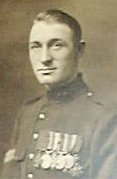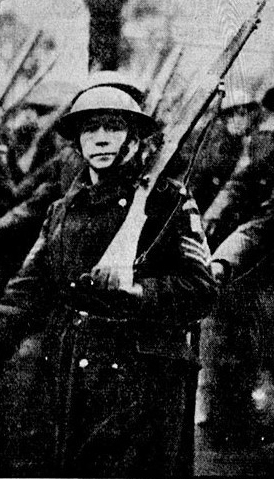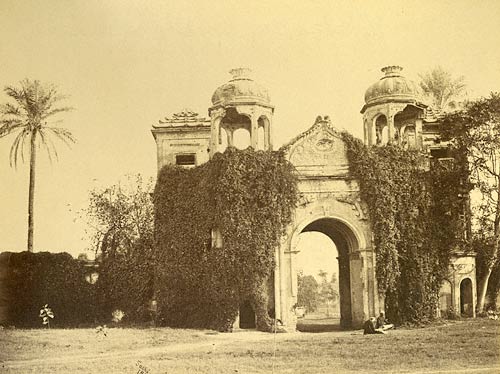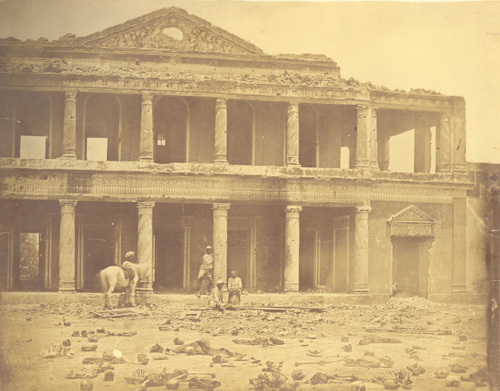The Victoria Cross
During the history of the Royal Dublin Fusiliers seven members of the regiment were awarded the Victoria Cross, the highest award for gallantry in the British army. Unusually all seven survived the actions in which they were awarded the medal.
Sergeant Horace Augustus Curtis
2nd Battalion Royal Dublin Fusiliers
Horace Augustus Curtis was born on the 7th of March 1891. He enlisted on the outbreak of war and went to Gallipoli with the 7th Battalion as part of the Machine Gun Section. He was reported as wounded in 1915 and served with the battalion until 1917 being mentioned in dispatches in July 1917. He was then transferred to the 2nd Battalion after the 7th was absorbed by them. On the 18th of October 1918 he was was awarded the Victoria Cross for most conspicuous bravery and devotion to duty , when in attack his platoon came unexpectedly under intense machine-gun fire. Realising that the attack would fail unless the enemy guns were silenced, Sjt Curtis, without hesitation, rushed forward through our own barrage and the enemy fire and killed and wounded the teams of two of the guns, whereupon the remaining four guns surrendered. Then turning his attention to a train-load of reinforcements, he succeeded in capturing over 100 enemy before his comrades joined him. His valour and disregaurd of danger inspired all, in action east of Le Cateau, France. He was presented with his Victoria Cross by the King in March 1919.
Sergeant Robert Downie
2nd Battalion Royal Dublin Fusiliers
Robert Downie VC MM was born on the 12th of January 1894 to Irish parents from Laurencetown, County Down. One of sixteen children he was educated at St. Aloysius Catholic, Springburn, Glasgow. He was awarded a Military Medal in 1916 before on the 23rd of October 1916 at Lesboeufs, France when most of the officers had become casualties, Sergeant Downie, utterly regardless of personal danger and under very heavy fire, organised the attack which had been temporarily checked. At the critical moment he rushed forward shouting “Come on the Dubs!” which had an immediate response and the line rushed forward at this call. Sergeant Downie accounted for several of the enemy and in addition captured a machine-gun, killing the team. Although wounded early in the fight, he remained with his company, giving valuable assistance while the position was being consolidated. After the war Robert lived his civilian life working sometimes at the turnstiles at Celtic Park, Glasgow. In 1929 he attended a Victoria Cross reunion in London and died aged 74 on the 18th of April 1968. He is buried St. Kentigern’s Cemetery, Glasgow.
Private Thomas Duffy
1st Madras Fusiliers
Thomas Duffy was born in 1805 at Caulry, Athlone, Co. Westmeath. He was awarded the Victoria Cross during the Indian rebellion of 1857 at the age of 52. On the 26th of September 1857 at Lucknow, India. A 24-pounder gun which had been used against the enemy on the previous day was left in an exposed position and all efforts to reach it were unsuccessful, so heavy was the fire maintained on it by the mutineers. Private Duffy, however, who went out with two others, managed to fasten a rope to the gun in such a manner that it could be pulled away and was saved from falling into the hands of the enemy. He died on the 24th of December 1868 and is buried in Glasnevin Cemetery, Dublin. His Victoria Cross is today held at the National Army Museum.
Sergeant Patrick Mahoney
1st Madras Fusiliers
Patrick Mahoney was born in 1827 at Waterford. He was awarded the Victoria Cross during the Indian rebellion of 1857 at the age of 30. On the 21st of September 1857 at Lucknow, India. Sergeant Mahoney with the Volunteer Cavalry, helped in the capture of the Regimental Colour of the 1st Regiment Native Infantry. He was killed in action at Lucknow, India on the 30th of October 1857, his burial location is unknown however his VC is held in the Oriental & India Office Collection, British Library, London.
Sergeant James Ockendon
1st Battalion Royal Dublin Fusiliers
James Ockendon VC MM was born on the 10th of December 1890 in Portsmouth, England. He joined the Royal Dublin Fusilier as a private in 1909 and landed with the 1st Battalion at ‘V’ Beach, Gallipoli on the 24th of April 1915. He won the Military Medal in August 1917 just before he won the V.C. on the 4th of October 1917 near Langemarck. He was acting as a Company Sergeant Major and seeing the platoon on the right held up by an enemy machine-gun, he immediately regardless of his own safety and captured it, killing the crew. He then led a section to the attack on a farm, where under very heavy fire he rushed forward and called on the garrison to surrender. As the enemy continued to fire on him he opened fire, killing four, whereupon the remaining 16 surrendered. He recieved his Victoria Cross from King George V on the 5th of December 1917. In 1918 he recieved the Belgian Croix de Guerre and was discharged from the army on the 30th of April 1918. He died on the 29th of August 1966 at 5 Yorke Street, Southsea, Hampshire and his remains were cremated at Porchester Crematorium.
Private John Ryan
1st Madras Fusiliers
John Ryan was born in 1823 at Kilkenny. He was awarded the Victoria Cross at the age of 34 during the Indian rebellion of 1857. A party of men was shut up and besieged in a house in the city. Private Ryan, in conjunction with another private (Peter McManus of the 5th Regiment)dashed into the street and took a wounded captain out of a dhooly and carried him into the house in spite of heavy fire in which the captain was again wounded. In addition to this Private Ryan devoted himself during the day to rescuing the wounded in the neighbourhood from being massacred. He was killed in action at Allahabad, India on the 27th of April 1859.
Private John Smith
1st Madras Fusiliers
John Smith in born on in July 1822 at London, he was awarded the Victoria Cross Secundra Bagh, Lucknow on the 16th of November 1857 during the Indian rebellion and was the only member of the regiment to be awarded the VC under Rule 13 of the Royal Warrant (being elected by the regiment). His citation which appears in the London Gazette on the 24th of December 1857 reads: “On 16th November, 1857 at Lucknow, India, Private Smith was one of the first to enter Secundra Bagh when the gateway on the north side had been burst open. He was immediately surrounded by the enemy but notwithstanding the fact that he received a sword cut on their head, a bayonet wound on the left side and bruising from the butt-end of a musket, he fought his way out and continued to perform his duties for the rest of the day.” He died aged 43 on the 6th of May 1866 while he was still in India and is buried in an unmarked grave Taujore Cemetery.








